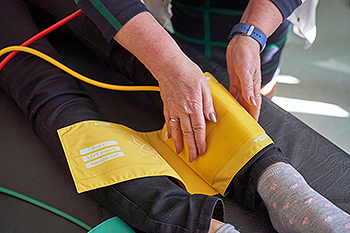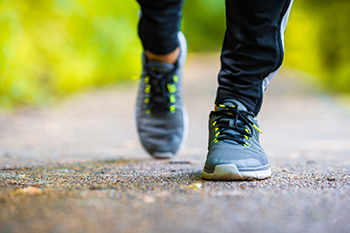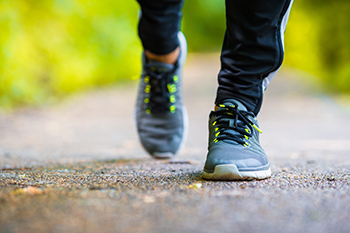
Peripheral artery disease, or PAD, is a widespread, yet often overlooked vascular condition affecting millions of Americans. Despite its prevalence, PAD's symptoms can be subtle, leading to under-diagnosis. These symptoms can include pain in the calves during activity, numbness, tingling, and slow-healing sores on the legs or feet. Peripheral artery disease occurs due to the accumulation of plaque in the blood vessels, which restricts blood flow to the lower extremities. Individuals with diabetes face a heightened risk as sores or bruises may not heal properly, leading to the formation of ulcers on the feet and lower legs. Risk factors for PAD include a family history of heart disease and hypertension. High cholesterol, smoking, obesity, and physical inactivity may also be factors. If you believe you have symptoms of PAD, it is suggested that you schedule an appointment with a podiatrist who is medically trained to manage this condition.
Peripheral artery disease can pose a serious risk to your health. It can increase the risk of stroke and heart attack. If you have symptoms of peripheral artery disease, consult with Leonora Fihman, DPM from California. Our doctor will assess your condition and provide you with quality foot and ankle treatment.
Peripheral artery disease (PAD) is when arteries are constricted due to plaque (fatty deposits) build-up. This results in less blood flow to the legs and other extremities. The main cause of PAD is atherosclerosis, in which plaque builds up in the arteries.
Symptoms
Symptoms of PAD include:
It is important to note that a majority of individuals never show any symptoms of PAD.
Diagnosis
While PAD occurs in the legs and arteries, Podiatrists can diagnose PAD. Podiatrists utilize a test called an ankle-brachial index (ABI). An ABI test compares blood pressure in your arm to you ankle to see if any abnormality occurs. Ultrasound and imaging devices may also be used.
Treatment
Fortunately, lifestyle changes such as maintaining a healthy diet, exercising, managing cholesterol and blood sugar levels, and quitting smoking, can all treat PAD. Medications that prevent clots from occurring can be prescribed. Finally, in some cases, surgery may be recommended.
If you have any questions, please feel free to contact our offices located in Encino and Brentwood, Los Angeles, CA . We offer the newest diagnostic and treatment technologies for all your foot care needs.

Foot drop is a condition marked by having difficulty lifting or moving the foot and toes. The foot fails to lift properly, causing a gait that looks like marching. Foot drop typically stems from nerve injuries as the result of sports injuries, spinal issues like slipped discs, or neuropathies associated with conditions such as diabetes. Other causes of drop foot include inherited conditions like Charcot-Marie-Tooth disease or neurological disorders, such as stroke or multiple sclerosis. Treatment strategies for foot drop are multifaceted, depending on the underlying cause and severity of symptoms. Certain exercises can play an important role in strengthening and stretching muscles to improve function. In addition, braces, splints, or custom orthotics may offer external support and aid in maintaining proper foot positioning. In cases of permanent impairment, surgical joint fusion or nerve repair may be necessary. Electrical nerve stimulation devices also can offer promising therapeutic options, particularly for individuals affected by stroke or multiple sclerosis. If you have symptoms of foot drop, it is suggested that you schedule an appointment with a podiatrist for an exam and diagnosis, followed by the appropriate treatment options.
If you have any concerns about your feet, contact Leonora Fihman, DPM from California. Our doctor can provide the care you need to keep you pain-free and on your feet.
Biomechanics in Podiatry
Podiatric biomechanics is a particular sector of specialty podiatry with licensed practitioners who are trained to diagnose and treat conditions affecting the foot, ankle and lower leg. Biomechanics deals with the forces that act against the body, causing an interference with the biological structures. It focuses on the movement of the ankle, the foot and the forces that interact with them.
A History of Biomechanics
Modern technological improvements are based on past theories and therapeutic processes that provide a better understanding of podiatric concepts for biomechanics. Computers can provide accurate information about the forces and patterns of the feet and lower legs.
Understanding biomechanics of the feet can help improve and eliminate pain, stopping further stress to the foot.
If you have any questions please feel free to contact our offices located in Encino and Brentwood, Los Angeles, CA . We offer the newest diagnostic and treatment technologies for all your foot and ankle needs.

Selecting the appropriate footwear is essential for a comfortable and effective power walking experience. Look for shoes specifically designed for walking, as they offer the necessary support and cushioning for prolonged activity. Opt for lightweight yet durable materials that allow breathability and flexibility, ensuring optimal comfort and performance. Consider shoes with ample cushioning in the heel and forefoot to absorb impact and reduce strain on the feet and joints. Look for a supportive midsole that provides stability and helps maintain proper alignment during each stride. Additionally, prioritize shoes with a roomy toe box to accommodate natural foot swelling and movement while minimizing the risk of blisters and discomfort. A supportive arch and a secure lacing system are also vital for a snug and stable fit. Take the time to try on different styles and brands, and pay attention to how each pair feels during walking movements. Investing in high-quality shoes that meet your specific needs can minimize the risk of discomfort or injury. Consult a podiatrist if you are seeking more information about what to look for while buying shoes.
Getting the right shoe size is an important part of proper foot health. Seek the assistance of Leonora Fihman, DPM from California. Our doctor will provide the care you need to keep you pain-free and on your feet.
Getting the Right Shoe Size
There are many people who wear shoes that are the incorrect size, negatively affecting their feet and posture. Selecting the right shoes is not a difficult process, so long as you keep several things in mind when it comes to choosing the right pair.
As our feet hold our body weight and keep us moving, it is important to treat them right. Picking the right pair of shoes can provide your feet comfort and mobility without pain.
If you have any questions, please feel free to contact our offices located in Encino and Brentwood, Los Angeles, CA . We offer the newest diagnostic and treatment technologies for all your foot care needs.
